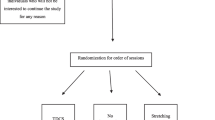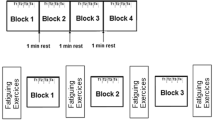Abstract
Purpose
This project aimed to quantify the effects of modifying computer work posture on neck/shoulder patterns during a prolonged typing task.
Method
Twenty healthy participants completed a 90-min typing task while sitting or walking on a treadmill. Electromyography (EMG) was recorded from eight upper body muscles and laser Doppler flowmetry (LDF) from two upper body sites. Effects of Time and Posture were assessed for EMG amplitude (RMS), variability (CoV), normalized mutual information (NMI), LDF and upper limb discomfort.
Results
Upper limb discomfort was higher during sitting and increased with time, from 0.86 ± 1.3 to 3.7 ± 3.1 out of 10. Interaction effects showed that EMG amplitude decreased over time for the lumbar erector spinae (LES) (from 6.3 ± 2.9 to 5.6 ± 3.2 % MIVC) and wrist extensor (from 12.4 ± 2.7 to 11.3 ± 3.5 % MIVC) during walking, but increased during sitting. Anterior Deltoid EMG amplitude was 64 % lower during walking while External Oblique EMG amplitude (43 %) and Lower Trapezius EMG variability (65 %) were higher during walking. Interaction effects showed higher LES CoV during walking compared to sitting (p = 0.019) in the beginning but not at the end of the task, and higher neck/shoulder NMI (p = 0.050) towards the end of the task during sitting compared to walking.
Conclusion
Results suggest that walking while performing computer work may be effective in inducing healthier muscular patterns, possibly explaining the lower level of discomfort compared to sitting.





Similar content being viewed by others
Abbreviations
- AD:
-
Anterior deltoid
- ANOVA:
-
Analysis of variance
- AWPM:
-
Adjusted words per minute
- CES:
-
Cervical erector spinae
- CoV:
-
Coefficient of variation
- EMG:
-
Electromyography
- EO:
-
External oblique
- FLDF:
-
Forearm laser Doppler flowmetry
- LDF:
-
Laser Doppler flowmetry
- LES:
-
Lumbar erector spinae
- LT:
-
Lower trapezius
- MI:
-
Mutual information
- MIVC:
-
Maximum isometric voluntary contractions
- MSDs:
-
Musculoskeletal disorders
- MT:
-
Middle trapezius
- NMI:
-
Normalized mutual information
- PSS:
-
Perceived stress scale
- RMS:
-
Root-mean-square
- SLDF:
-
Shoulder laser Doppler flowmetry
- UL:
-
Upper limb
- UT:
-
Upper trapezius
- WaW:
-
Walk-and-work
- Wext:
-
Wrist extensor
- WRMSD:
-
Work-related musculoskeletal disorder
References
Aaras A, Fostervold KI, Ro O, Thoresen M, Larsen S (1997) Postural load during VDU work: a comparison between various work postures. Ergonomics 40:1255–1268. doi:10.1080/001401397187496
Andersen LL, Blangsted AK, Nielsen PK, Hansen L, Vedsted P, Sjogaard G, Sogaard K (2010) Effect of cycling on oxygenation of relaxed neck/shoulder muscles in women with and without chronic pain. Eur J Appl Physiol 110:389–394. doi:10.1007/s00421-010-1517-4
Antle DM, Cote JN (2013) Relationships between lower limb and trunk discomfort and vascular, muscular and kinetic outcomes during stationary standing work. Gait Posture 37:615–619. doi:10.1016/j.gaitpost.2012.10.004
Basmajian JV, Blumenstein R (1980) Electrode placement in EMG biofeedback. Williams & Wilkins, Baltimore
Ben-Ner A, Hamann DJ, Koepp G, Manohar CU, Levine J (2014) Treadmill workstations: the effects of walking while working on physical activity and work performance. PLoS ONE 9(2):e88620. doi:10.1371/journal.pone.0088620
Blangsted AK, Sogaard K, Christensen H, Sjogaard G (2004) The effect of physical and psychosocial loads on the trapezius muscle activity during computer keying tasks and rest periods. Eur J Appl Physiol 91:253–258. doi:10.1007/s00421-003-0979-z
Cagnie B, Danneels L, Van Tiggelen D, De Loose V, Cambier D (2007) Individual and work related risk factors for neck pain among office workers: a cross sectional study. Eur Spine J 16:679–686. doi:10.1007/s00586-006-0269-7
Cohen S, Williamson GM (1988) Perceived stress in a probability sample of the United-States. In: Spacapam S, Oskamp S (eds) The social psychology of health. Sage, Newbury Park
Cooper A, Straker L (1998) Mouse versus keyboard use: a comparison of shoulder muscle load. Int J Ind Ergonom 22:351–357. doi:10.1016/s0169-8141(97)00088-7
Fedorowich L, Emery K, Gervasi B, Cote JN (2013) Gender differences in neck/shoulder muscular patterns in response to repetitive motion induced fatigue. J Electromyogr Kinesiol 23:1183–1189. doi:10.1016/j.jelekin.2013.06.005
Forde MS, Punnett L, Wegman DH (2002) Pathomechanisms of work-related musculoskeletal disorders: conceptual issues. Ergonomics 45:619–630. doi:10.1080/00140130210153487
Funk RE, Taylor ML, Creekmur CC, Ohlinger CM, Cox RH, Berg WP (2012) Effect of walking speed on typing performance using an active workstation. Percept Motor Skill 115:309–318. doi:10.2466/06.23.26.pms.115.4.309-318
Grandjean E, Kroemer KHE (1997) Fitting the task to the human: A textbook of occupational ergonomics, 5th edn. Taylor & Francis, Philadelphia
Green D, Cheetham C, Mavaddat L, Watts K, Best M, Taylor R, O’Driscoll G (2002) Effect of lower limb exercise on forearm vascular function: contribution of nitric oxide. Am J Physiol-Heart C 283:H899–H907. doi:10.1152/ajpheart.00049.2002
Jeong J, Gore JC, Peterson BS (2001) Mutual information analysis of the EEG in patients with Alzheimer’s disease. Clin Neurophysiol 112:827–835
Johansen TI, Samani A, Antle DM, Cote JN, Madeleine P (2013) Gender effects on the coordination of subdivisions of the trapezius muscle during a repetitive box-folding task. Eur J Appl Physiol 113:175–182. doi:10.1007/s00421-012-2425-6
Johansson H, Sjolander P, Djupsjobacka M, Bergenheim M, Pedersen J (1999) Pathophysiological mechanisms behind work-related muscle pain syndromes. Am J Ind Med 36:104–106
John D, Bassett D, Thompson D, Fairbrother J, Baldwin D (2009) Effect of using a treadmill workstation on performance of simulated office work tasks. J Phys Act Hea 6:617–624
Keller K, Corbett J, Nichols D (1998) Repetitive strain injury in computer keyboard users: pathomechanics and treatment principles in individual and group intervention. J Hand Ther 11:9–26
Kleine BU, Schumann NP, Bradl I, Grieshaber R, Scholle HC (1999) Surface EMG of shoulder and back muscles and posture analysis in secretaries typing at visual display units. Int Arch Occ Environ Health 72:387–394. doi:10.1007/s004200050390
Kojadinovic I (2005) Relevance measures for subset variable selection in regression problems based on k-additive mutual information. Comput Stat Data Anal 49:1205–1227. doi:10.1016/j.csda.2004.07.026
Larsson B, Sogaard K, Rosendal L (2007) Work related neck-shoulder pain: a review on magnitude, risk factors, biochemical characteristics, clinical picture and preventive interventions. Best Pract Res Clin Rheumatol 21:447–463. doi:10.1016/j.berh.2007.02.015
Latash ML, Scholz JP, Schoner G (2002) Motor control strategies revealed in the structure of motor variability. Exerc Sport Sci Rev 30:26–31. doi:10.1097/00003677-200201000-00006
Levine JA, Miller JM (2007) The energy expenditure of using a “walk-and-work” desk for office workers with obesity. Br J Sports Med 41:558–561. doi:10.1136/bjsm.2006.032755
Madeleine P, Mathiassen SE, Arendt-Nielsen L (2008a) Changes in the degree of motor variability associated with experimental and chronic neck-shoulder pain during a standardised repetitive arm movement. Exp Brain Res 185:689–698. doi:10.1007/s00221-007-1199-2
Madeleine P, Voigt M, Mathiassen SE (2008b) The size of cycle-to-cycle variability in biomechanical exposure among butchers performing a standardised cutting task. Ergonomics 51:1078–1095. doi:10.1080/00140130801958659
Madeleine P, Samani A, Binderup AT, Stensdotter AK (2011) Changes in the spatio-temporal organization of the trapezius muscle activity in response to eccentric contractions. Scand J Med Sci Sports 21:277–286. doi:10.1111/j.1600-0838.2009.01037.x
Mathiassen SE, Moller T, Forsman M (2003) Variability in mechanical exposure within and between individuals performing a highly constrained industrial work task. Ergonomics 46:800–824. doi:10.1080/0014013031000090125
Messing KVN, Major M, Ouellet S, Tissot F, Couture V et al (2008) Body maps: an indicator of physical pain for worker-oriented ergonomic interventions. Pol Pract Health Safety 6:31–49
Mork PJ, Westgaard RH (2009) Back posture and low back muscle activity in female computer workers: a field study. Clin Biomech 24:169–175. doi:10.1016/j.clinbiomech.2008.11.001
Moseley GL, Hodges PW (2006) Reduced variability of postural strategy prevents normalization of motor changes induced by back pain: a risk factor for chronic trouble? Behav Neurosci 120:474–476. doi:10.1037/0735-7044.120.2.474
Nachemson A (1966) The load on lumbar disks in different positions of the body. Clin Orthop Relat Res 45:107–122
Roe C, Knardahl S (2002) Muscle activity and blood flux during standardised data-terminal work. Int J Ind Ergonom 30:251–264. doi:10.1016/s0169-8141(02)00129-4
Stock S, Funes A, DelisleA, St-Vincent M, Turcot A, Messing M (2011) Troubles musculo-squelettiques. In: Vézina M et al. Enquête québécoise sur des conditions de travail, d’emploi, et de santé et de sécurité du travail (EQCOTESST), Chapitre 7. Institut de recherche Robert-Sauvé en santé et sécurité du travail—Institut national de santé publique du Québec et Institut de la statistique du Québec
Straker L, Levine J, Campbell A (2009) the effects of walking and cycling computer workstations on keyboard and mouse performance. Hum Factors 51:831–844. doi:10.1177/0018720810362079
Strom V, Knardahl S, Stanghelle JK, Roe C (2009a) Pain induced by a single simulated office-work session: time course and association with muscle blood flux and muscle activity. Eur J Pain 13:843–852. doi:10.1016/j.ejpain.2008.11.003
Strom V, Roe C, Knardahl S (2009b) Work-induced pain, trapezius blood flux, and muscle activity in workers with chronic shoulder and neck pain. Pain 144:147–155. doi:10.1016/j.pain.2009.04.002
Svendsen JH, Samani A, Mayntzhusen K, Madeleine P (2011) Muscle coordination and force variability during static and dynamic tracking tasks. Hum Movement Sci 30:1039–1051. doi:10.1016/j.humov.2011.02.001
Tanaka H, Shimizu S, Ohmori F, Muraoka Y, Kumagai M, Yoshizawa M, Kagaya A (2006) Increases in blood flow and shear stress to nonworking limbs during incremental exercise. Med Sci Sport Exer 38:81–85. doi:10.1249/01.mss.0000191166.81789.de
Thompson WG, Foster RC, Eide DS, Levine JA (2008) Feasibility of a walking workstation to increase daily walking. Br J Sports Med 42:225–228. doi:10.1136/bjsm.2007.039479 (discussion 228)
Wilke HJ, Neef P, Hinz B, Seidel H, Claes L (2001) Intradiscal pressure together with anthropometric data - a data set for the validation of models. ClinBiomech 16:S111–S126. doi:10.1016/s0268-0033(00)00103-0
Acknowledgments
In addition to the participants in the study, the authors wish to thank David Antle, Amanda Farias and Zach Weber for their assistance in data collection and analyses. This research was supported by grant Grants from the Canadian Foundation for Innovation and the Institut de Recherche Robert-Sauvé en Santé etenSécurité du Travail (IRSST). Julie Côté holds a Gender, Work and HealthResearch Chair from the Canadian Institutes for HealthResearch and the IRSST.
Conflict of interest
No author has financial or personal conflicts of interest that could inappropriately influence their work.
Author information
Authors and Affiliations
Corresponding author
Additional information
Communicated by Fausto Baldissera.
Rights and permissions
About this article
Cite this article
Fedorowich, L.M., Emery, K. & Côté, J.N. The effect of walking while typing on neck/shoulder patterns. Eur J Appl Physiol 115, 1813–1823 (2015). https://doi.org/10.1007/s00421-015-3163-3
Received:
Accepted:
Published:
Issue Date:
DOI: https://doi.org/10.1007/s00421-015-3163-3




